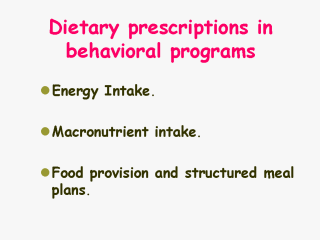| front |1 |2 |3 |4 |5 |6 |7 |8 |9 |10 |11 |12 |13 |14 |15 |16 |17 |18 |19 |20 |21 |22 |23 |24 |25 |26 |review |
 |
Energy:This may be
done on an individual basis, by estimating current calorie intake and then subtracting 500
to 1000 kcal/day. In some studies current intake is estimated by multiplying the patients'
weight in pounds by 12, and in others resting energy expenditure is estimated and an
adjustment made for the patients' activity level. Alternatively in many programs,
participants are simply assigned a calorie goal depending on their initial body weight
(e.g. patients < 200 lb may be asked to eat 1000-1200 kcal/day and those > 200 lb
may be asked to eat 1500 kcal/day). Macro: lower their fat intake to 20-30% of their calories in order to improve weight loss and lipid responses to weight loss. The combination of restricting dietary fat and calories has been shown to be more effective then fat restriction alone [22] or calorie restriction alone [23, 24]. Moreover, reducing fat intake and decreasing consumption of specific high fat food (beef, hot dogs, cheese, French fries, sweets) have been shown to be related to maintenance of weight loss [25, 26]. Food: Behaviorists have long recognized the importance of modifying the home environment as a means of influencing eating behaviors. Patients in behavioral weight loss programs are encouraged to select foods that will provide the greatest nutritional benefit for the fewest calories. The emphasis in on decreasing overall intake of fat. Strategies are provided for improving quality of foods consumed at home and when eating out. |